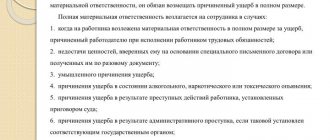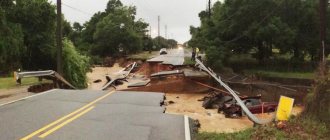Every citizen of the country must understand that for normal civilized living it is necessary to follow certain rules of behavior and be responsible for their actions. If a person commits a crime, it will be discovered and punished. This is an inevitable phenomenon, which allows us to say that every person in the country is protected by the state, or more precisely, by executive bodies such as the police. In order for the perpetrator to be held accountable for the crime committed, it is necessary to initially create an evidence base that will undoubtedly confirm the fact of his guilt or innocence.
One of the crimes is significant damage under the Criminal Code of the Russian Federation, which was caused to the other party. The criminal action consists of causing significant material damage to the injured party. This act is qualified by Art. 167 of the Criminal Code of the Russian Federation.
Criminal Code, Art. 167
In order to understand what we are talking about, let’s consider what the article of the Criminal Code says about the subject of the crime. What is significant damage under the Criminal Code of the Russian Federation?
The subject of the crime is the property of the other party (the defendant), the damage to which was, in fact, caused. That is, significant damage can be called not only the destruction, but also damage to the property of another citizen.
The subject of the crime must have a marketable value, that is, a price that can be determined by an objective method. As for the conditions under which the crime was committed, they also matter. In the modern world, we increasingly hear about terrorist acts and vandalism; for these conditions, other relevant articles of the criminal code are defined, which provide for a completely different punishment.
In order to have a clear distinction between the destruction of property and its damage, let us consider what the Criminal Code defines as the destruction of property and its damage.
What factors can influence the amount of damage?
An expert report on the inspection of a vehicle after an accident is the main document by which the amount of damage is calculated. As hidden damage is discovered or additional examinations are carried out, information may be added to it. Information for calculating repair costs is taken from this act.
Important criteria for assessing the condition of a car:
- vehicle brand;
- the year of its production and registration;
- equipment of the car at the time of purchase;
- the city where the car was registered and where the accident occurred;
- what condition was the car in before the accident;
- What is the condition of the parts requiring replacement?
The insurance company uses average cost indicators to calculate the cost of repairs:
- repair work;
- materials for work;
- spare parts for replacement.
The last indicator is taken from the Unified Electronic Directory of Prices for Auto Parts, compiled by RSA. It is posted on the Internet, in the public domain. The directory is periodically updated. Essentially, this is a simple calculator. To calculate the price, you need to indicate the date of the accident, the make of the car, the economic zone number and the spare part number.
Indicators that reduce the amount of compensation:
- wear of damaged spare parts (expressed as a percentage);
- year of vehicle manufacture, operating time;
- distance traveled in kilometers.
If repairs are impossible or their cost will be more than the cost of a new car, the insurance company is obliged to pay compensation in an amount sufficient to purchase a new car. The calculation method is also used here. The cost of whole spare parts is subtracted from the estimated cost of a new car. It is assumed that the owner will be able to implement them. The coefficients for calculating their cost are also determined by EMRU.
In addition to compensation for property damage after an accident, compensation can be made for harm to life and health caused by the accident. The government approved the rules for calculating insurance amounts and determined the standards for calculating the amount of compensation in Resolution No. 1164 of November 15, 2012.
Destruction of property
Destruction of property refers to the criminal actions of a citizen, as a result of which the property of another person was rendered unusable, that is, it cannot be repaired and cannot be used for its original purpose. The damage in such circumstances is "significant".
This article provides for punishment for persons aged 16 or 14 years. Moreover, it makes no difference what prompted a person to commit this crime. Also, the article does not take into account the motive for the crime, unless it is another criminal act. In this case, we can give an example. The criminal, in order to hide the theft, set fire to the house. Then he will be convicted of committing theft and damaging property at the same time.
Compensation for material damage
How to achieve justice in this case and receive compensation corresponding to the real value of the stolen expensive items. To do this, you need to contact professional appraisers who will determine the market value of the stolen property. Most often, this procedure is carried out as part of a forensic examination.
Interregional Center for Expertise and Valuation, you can receive qualified assistance in determining the value of stolen property. In addition to appropriate education, the appraisers working for us have extensive experience in appraising property of various types. A professional and objective approach allows you to understand the most complex issues, when a stolen item is practically rendered unusable and has lost its original appearance.
It is especially important that when determining the value of stolen goods, the appraiser relies on its actual price at the time of the theft. If the initial cost cannot be determined, the assessment is made on the basis of an expert opinion.
An examination carried out simultaneously with the assessment work will help to make an objective conclusion about the volume of theft and establish the amount of compensation for the damage caused. The assessment report is an official document according to which the court will make a decision on the payment of compensation.
Damaging or destroying someone else's property
If a citizen, as a result of illegal actions, damages or damages property that is owned by another citizen, then this will be qualified under Article 167 of the Criminal Code of the Russian Federation.
What is property damage? Damage is the actions of the perpetrator, which led to the partial loss of the object’s external data and performance characteristics. As a result, the damaged property requires repairs, after which it is possible to restore its original purpose.
That is, if even repairs do not help when property is destroyed, then in the case of damage after repair, the item can be used by the owner. But restoring an item will require physical effort and financial investment, and it also takes time.
How can MCEO help?
In addition to material items, sometimes things that have no economic value are stolen. These can be manuscripts, dissertations, theses, valuable documents, handicrafts, and so on. The professional training of MCEO experts and appraisers allows us to establish the amount of damage from the theft of all of the above valuables and submit a report to the court containing all the results obtained as a result of a thorough study.
In some cases, the appraiser has to examine not the theft itself, but the documentation related to it. This may be due to the absence of the stolen item or its complete loss of its original properties. In these cases, an experienced appraiser also calculates the amount of damage caused, guided not only by the data specified in the documentation, but also by his own knowledge.
The assessment of damage from theft is more of a legal nature than an economic one. The final amount is determined by the court. However, an equally important role is assigned to the appraiser, who establishes the market value of the stolen property. The appraiser also has the right to act in court as an expert. Consequently, the fundamental document during a trial is its conclusion determining the cost of damage.
The conclusion must be made in accordance with the requirements of Law of the Russian Federation No. 73, which regulates the appraisal activities of organizations and companies of the relevant specifics.
The significant advantages of MCEO are the independent performance of expert and assessment work, as well as the provision of legal support to clients, which significantly increases the chance of receiving compensation for damage in the amount corresponding to the loss. By calling, you will learn about the rules for conducting an assessment and will be able to consult with a specialist.
What is the punishment?
Art. 167 of the Criminal Code of the Russian Federation consists of two parts. According to Part 1, a person who is 16 years old is subject to punishment for actions that resulted in damage to someone else’s property.
In part 2 of this article, persons who have reached 14 years of age may be subject to punishment.
If the actions of the perpetrator are considered under Article 167 Part 1, then he may face the following punishment:
- fine up to 40 thousand rubles;
- a fine in the amount of wages or other income received by the perpetrator, in the amount of three months' income;
- correctional labor up to 360 hours;
- correctional labor for up to 12 months;
- compulsory work for up to two years;
- arrest for up to 3 months;
- imprisonment up to 24 months.
If the perpetrator is tried under Article 167 Part 2, then he may face the following punishment:
- compulsory correctional labor for up to 5 years;
- imprisonment for up to 5 years.
Comment on the article
The commentary to Article 167 states that Part 2 applies in cases where the actions of the perpetrator or perpetrators were committed for reasons of hooliganism. Moreover, destruction or damage to property is recognized as an intentional act. If in such a case a person was injured, then this will be considered as an unintentional infliction of significant damage or harm to health.
Two sides of the crime
There are two sides to this crime - objective and subjective. The objective side is when deliberate actions were aimed precisely at ensuring that the property lost its economic and material value, which, in fact, happened.
Speaking about the subjective side, it is worth noting that this may not be a purposeful action, but a person’s disdainful attitude towards someone else’s property, which entailed a complete or partial loss of the property’s material, economic and consumer value.
In order to understand more clearly how this can happen, we will give the simplest example. A person deliberately decided to set fire to his own property, but as a result of the fire, someone else’s property was also destroyed. In this case, Article 167 of the Criminal Code of the Russian Federation applies.
Hooligan urges
If the actions of the perpetrator are hooligan in nature, then this implies the commission of a criminal act that had no reason or the reason was not significant. Hooliganism in this case is an action aimed at deliberately damaging property belonging to another person. The only goal of the offender is the desire to cause concern to others, this is often done when teenagers want to assert themselves in this way. Significant damage to an individual under Art. 167 of the Criminal Code of the Russian Federation is punished, regardless of what forced the perpetrator to do it.
If a person has not reached the age that can be held accountable, then a parent or other person who represents the interests of the perpetrator will bear it for him. This could be a guardian. Article 167 applies in situations where significant damage has been caused under the Criminal Code of the Russian Federation.
Assessment of the significance of damage
In order for a criminal act to be qualified under Article 167 of the Criminal Code of the Russian Federation, it is necessary to prove that the amount of damage allows it to be classified as significant. Legislative acts do not provide a clear distinction on this issue.
How much is significant damage under the Criminal Code of the Russian Federation? It is only noted that the minimum amount of damage that can be qualified as “significant” can be 2,500 rubles. But still, it can change depending on the level of income of the victim.
There is also no clear distinction regarding damage caused to municipal or commercial enterprises. It would be incorrect to say that “the damage caused did not have a significant impact on the injured party.” The law states that the significance of the damage caused should be determined only for the individual. Significant damage to an individual under Art. 167 of the Criminal Code of the Russian Federation is determined at a minimum amount of 2.5 thousand rubles. This is a minimum amount that does not depend on the income level of the victim.
What damage is considered significant when it comes to an enterprise or organization? When causing damage to an organization or enterprise, the most important assessment feature is the study of all the circumstances of the case under consideration. For such cases, it will be considered that the amount of significant damage in terms of cost will be in the range from 2,500 to 250,000 rubles. In each situation, this factor must be assessed individually.
Vehicle examination after an accident
The result of the initial examination will be a report on the condition of the car after the accident. It indicates information regarding the place and time of the expert assessment. They also list the participants in the road accident present during the examination, clarify information about the general condition of the vehicle, the presence of defects not related to the accident, and the presence/absence of hidden damage. Photo and video evidence confirming the facts of the inspection may be attached to the report. A second examination may be required if hidden damage is detected.
Currently, priority is given to remedial repairs rather than monetary payments. Therefore, before calculating the cost of damage from an accident, experts first of all evaluate:
- how deformed the surface is;
- the degree of damage to spare parts at the point of impact;
- percentage of damage to components and assemblies requiring their complete replacement.
Based on the study, the expert makes a decision on the possibility of restorative repairs or complete replacement of individual parts of the vehicle. Using the methodology, he calculates the cost of repair work and the amount of monetary compensation for damage after a traffic accident. The report is filled out within 3 to 10 days after inspection of the car.
The scope of repair work is contained in the fifth chapter of the methodology. It is large and quite confusing, but a must-read for all car owners. To determine the feasibility of repairs, the expert is guided by the sixth chapter of the methodology.








